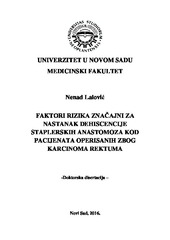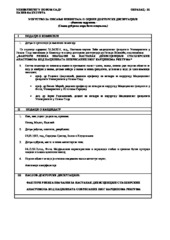Faktori rizika značajni za nastanak dehiscencije staplerskih anastomoza kod pacijenata operisanih zbog karcinoma rektuma
Risk factors significant for development of dehiscence of stapler anastomosis in patients with rectal cancer removed
| dc.contributor.advisor | Ivanov, Dejan | |
| dc.contributor.other | Cvijanović, Radovan | |
| dc.contributor.other | Trifunović, Bratislav | |
| dc.contributor.other | Marić, Radmila | |
| dc.contributor.other | Marić, Veljko | |
| dc.contributor.other | Radovanović, Zoran | |
| dc.creator | Lalović, Nenad | |
| dc.date.accessioned | 2016-10-08T15:47:48Z | |
| dc.date.available | 2016-10-08T15:47:48Z | |
| dc.date.available | 2020-07-03T13:24:00Z | |
| dc.date.issued | 2016-09-26 | |
| dc.identifier.uri | https://nardus.mpn.gov.rs/handle/123456789/6660 | |
| dc.identifier.uri | http://www.cris.uns.ac.rs/DownloadFileServlet/Disertacija146614516444635.pdf?controlNumber=(BISIS)101255&fileName=146614516444635.pdf&id=6049&source=NaRDuS&language=sr | sr |
| dc.identifier.uri | http://www.cris.uns.ac.rs/record.jsf?recordId=101255&source=NaRDuS&language=sr | sr |
| dc.identifier.uri | http://www.cris.uns.ac.rs/DownloadFileServlet/IzvestajKomisije146614517304077.pdf?controlNumber=(BISIS)101255&fileName=146614517304077.pdf&id=6050&source=NaRDuS&language=sr | sr |
| dc.description.abstract | UVOD: Kolorektalna anastomoza koja se formira u dubini karlice radi uspostavljanja kontinuiteta gastrointestinalnog trakta nakon resekcije dijela crijeva ima svoje specifičnosti u toku formiranja, zarastanja, kao i kada se jave komplikacije. Na sam proces zarastanja kolorektalnih anastomoza utiču sistemski, lokalni i tehnički faktori. Bilo kakav kompromis po pitanju ovih principa nosi povećan rizik od komplikacija! Najteža komplikacija na anastomozi je dehiscencija. „Samo neučinjena anastomoza neće dehiscirati“. Ova stara hirurška poslovica je važeća i danas, a što je anastomoza distalnija, mogućnost dehiscencije je veća, posebno kod niskih subperitonealnih anastomoza sa rektumom ili anusom. Učestalost dehiscencija ovih anastomoza u literaturi varira od 0,5 - 69 %, što može ukazivati na kvalitet hirurškog rada, korišćenje definicije dehiscencije, način dijagnostike, itd. Međunarodna grupa za karcinom rektuma definisala je dehiscenciju anastomoze kao defekt crijevnog zida, uključujući šavnu ili staplersku liniju neorektalnog rezervoara, što dovodi do komunikacije između intra i ekstra luminalnog prostora. CILJEVI: Osnovni cilj ove studije je bio da se utvrde preoperativni i perioperativni faktori rizika značajni za nastanak dehiscencija kolorektalnih anastomoza, kao i značaj prokalcitonina i C-reaktivnog proteina u detekciji dehiscencija kolorektalnih anastomoza u subkliničkoj fazi bolesti. MATERIJAL I METODOLOGIJA: Istraživanjem je obuhvaćeno 100 pacijenata operisanih u elektivnom programu, kod kojih je urađena radikalna operacija karcinoma rektuma uz kreiranje dvostruke staplerske kolorektalne anastomoze. Svi pacijenti uključeni u istraživanje, odabrani metodom slučajnog izbora, bili su podijeljeni u dvije grupe. Grupa A: pacijenti kod kojih je urađena radikalna operacija karcinoma rektuma i kreirana primarna staplerska kolorektalna anastomoza. Grupa B: pacijenti kod kojih je urađena radikalna operacija karcinoma rektuma Hartmanovom procedurom u prvom aktu, a rekonstrukcija kontinuiteta gastrointestinalnog trakta uspostavljena u drugom aktu kreiranjem sekundarne staplerske kolorektalne anastomoze. Primjenom statističkih testova analizirani su preoperativni (pol, godine života, komorbiditeti, ASA skor, indeks tjelesne mase preoperativna primjena hemoradioterapije, laboratorijske analize) i perioperativni (vrijeme trajanja operacije, udaljenost anastomoze od anokutane linije, veličina tumora u cm, intraoperativna primjena krvi) faktori rizika za nastanak dehiscencije anastomoze kod obje grupe. Kod svih pacijenata drugog i četvrtog postoperativnog dana kontrolisane su vrijednosti C reaktivnog proteina i prokalcitonina u serumu, bez obzira da li su postojali ili ne klinički manifestni znaci dehiscencije anastomoze. Takođe, primjenom ROC krive analizirana je senzitivnost, specifičnost i dijagnostička tačnost C reaktivnog proteina i prokalcitonina drugog i četvrtog postoperativnog dana u detekciji dehiscencije kolorektalne anastomoze. REZULTATI: Nema statistički značajne razlike u pojavi dehiscencije anastomoze između primarnih i sekundarnih dvostrukih staplerskih anastomoza. Incidencija dehiscencija anastomoza je bila 11% u ukupnom uzorku. Osam pacijenata je reoperisano, dok su tri pacijenta tretirana konzervativno. Kod tri pacijenta, kod kojih je nastala dehiscencija i koji su reoperisani, zbog posljedice sepse i septičnog šoka nastupio je smrtni ishod. Pol, godine života, komorbiditeti, stadijum bolesti, dužina trajanja operacije, intraoperativna primjena krvi, nisu statistički značajni faktori rizika (p>0,05) za nastanak dehiscencije primarnih i sekundarnih dvostrukih staplerskih kolorektalnih anastomoza. Udaljenost anastomoze od anokutane linije (<7cm), veličina tumora preko 5 cm su statistički značajni faktori rizika za nastanak dehiscencije anastomoze. Postoji visoko statistički značajna razlika (p<0,001) vrijednosti CRP-a i PCT-a četvrtog postoperativnog dana kod bolesnika sa i bez prisutne dehiscenecije kolorektalne anastomoze. Na osnovu ROC analize CRP–a za četvrti postoperativni dan, za graničnu vrijednost od 130 mg/l senzitivnost iznosi 82%, specifičnost 96% i dijagnostička tačnost 94%. Za graničnu vrijednost PCT-a od 0,78 ng/ml za četvrti postoperativni dan primjenom ROC krive utvrđena je sezitivnost 91%, specifičnost 92%, dok je dijagnostička tačnost bila 86%. Četvrti postoperativni dan CRP ima veću dijagnostičku tačnost i specifičnost u detekciji dehiscencije kolorektalne anastomoze u odnosu na PCT. ZAKLJUČAK: I pored velikog tehnološkog napretka, usavršavanja hirurških tehnika, boljeg razumijevanja prirode maligne bolesti, unapređivanja intraoperativnog i postoperativnog kontinuiranog praćenja bolesnika, uvođenja novih antimikrobnih lijekova, problem u liječenju i pojava dehiscencija kolorektalnih anastomoza su i dalje značajno prisutni. Otkrivanjem dehiscencija kolorektalnih anastomoza u subkliničkoj fazi, identifikovanje preoperativnih i perioperativnih faktora rizika značajnih za nastanak dehiscencija, omogućilo bi da se dehiscencija ranije uoči i efikasnije riješi. | sr |
| dc.description.abstract | INTRODUCTION: Colorectal anastomosis, which is formed deep in the pelvis because of establishment of continuity of gastrointestinal tract after resection of the part of intestines, has got its specifities during forming and healing process and when complications occur. Systemic, local and technical factors influence the healing process of anastomosis itself. Any kind of compromise in terms of these principles causes higher risk of complications! The most serious complication of anastomosis is dehiscence. “Only anastomosis which is not carried out will not dehisce.” This old surgical saying is still true, and the more distal anastomosis is, the possibility of development of dehiscence is higher, especially in lower subperitoneal anastomosis with rectum and anus. Incidence of dehiscence of these anastomosis in literature varies from 0,5 to 69 %, which may indicate the quality of surgical work, use of definition of dehiscence, kind of diagnostics etc. International group for rectal cancer defined dehiscence of anastomosis as a defect of intestinal wall, including suturing or stapler line of neorectal reservoir, which leads to communication between intra and extra luminal space. AIMS: Basic aim of this study was to determine preoperative and postoperative risk factors significant for the development of dehiscence of colorectal anastomosis, as well as significance of procalcitonin and C-reactive protein in detection of dehiscence of colorectal anastomosis at the subclinical stage of the disease. MATERIAL AND METHODOLOGY: The study included 100 patients operated on in the elective programme, on which radical operation of the rectal cancer was carried out with creation of double stapler colorectal anastomosis. All patients included in the study were randomly chosen and divided into two groups. Group A: the patients on which radical operation of the rectal cancer was carried out and primary stapler colorectal anastomosis created. Group B: the patients on which radical operation of the rectal cancer was carried out using Hartman's procedure in the first act, and reconstruction of the continuity of gastrointestinal tract was established in the second act by creation of secondary stapler colorectal anastomosis. By application of statistical tests preoperative (sex, age, comorbidities, ASA score, body mass index, preoperative application of haemoradiotherapy, laboratory analyses) and perioperative (duration of operation, distance of anastomosis from anocutaneous line, size of tumor in cm, intraoperative application of blood) risk factors for development of dehiscence of anastomosis in both groups were analysed. In all patients on the second and fourth postoperative day values of C-reactive protein and procalcitonin in the serum were analysed, regardless of the existence of clinically or non-clinically manifested signs of dehiscence of anastomosis. Also, sensitivity, specifity and diagnostically accurate C-reactive protein and procalcitonin on the second and fourth postoperative day in detection of dehiscence of colorectal anastomosis were analysed by application of ROC curve. RESULTS: There is no statistically significant difference in the development of dehiscence of anastomosis between primary and secondary double stapler anastomosis. Incidence of dehiscence of anastomosis was 11% in all samples. Eight patients were reoperated on, whereas three patients were treated conservatively. In three patients who developed dehiscence and were reoperated on, the death occurred due to sepsis and septic shock. Sex, age, comorbidities, stage of the disease, duration of operation, intraoperative application of blood were not statistically significant risk factors (p>0,05) for the development of dehiscence of primary and secondary double stapler colorectal anastomosis. Distance of anastomosis from anocutaneous line (<7cm), size of tumor over 5 cm were statistically significant risk factors for the development of dehiscence of anastomosis. There is highly statistically significant difference (p<0,001) values of CRP and PCT on the fourth postoperative day in patients with and without dehiscence of colorectal anastomosis. On the basis of ROC analysis of CRP for the fourth postoperative day, for the bordering value of 130 mg/l sensitivity is 82%, specificity 96% and diagnostic accuracy 94%. For bordering value of PCT of 0,78 ng/ml for the fourth postoperative day, by application of ROC curve, the following values were determined: sensitivity 91%, specificity 92% and diagnostic accuracy 86%. CRP for the fourth postoperative day has got higher diagnostic accuracy and specificity in detection of dehiscence of colorectal anastomosis in relation to PCT. CONCLUSION: In spite of huge technological advance, improvement of surgical techniques, better understanding of the nature of malignant diseases, improvement of intraoperative and postoperative continuous follow up of the patient, introduction of new antimicrobial medicines, the problem in treating and development of dehiscence of colorectal anastomosis is still significantly present. Detection of dehiscence of colorectal anastomosis at the subclinical stage, identification of preoperative and perioperative risk factors significant for the development of dehiscence would help in early detection of dehiscence and contribute to more effective operations. | en |
| dc.language | sr (latin script) | |
| dc.publisher | Универзитет у Новом Саду, Медицински факултет | sr |
| dc.rights | openAccess | en |
| dc.rights.uri | https://creativecommons.org/licenses/by-nc-nd/4.0/ | |
| dc.source | Универзитет у Новом Саду | sr |
| dc.subject | rektalne neoplazme | sr |
| dc.subject | Rectal Neoplasms | en |
| dc.subject | Surgical Wound Dehiscence | en |
| dc.subject | Risk Factors | en |
| dc.subject | Colorectal Surgery | en |
| dc.subject | Anastomosis | en |
| dc.subject | Surgical | en |
| dc.subject | C-Reactive Protein | en |
| dc.subject | Calcitonin | en |
| dc.subject | Early Diagnosis | en |
| dc.subject | dehiscencija hirurške rane | sr |
| dc.subject | faktori rizika | sr |
| dc.subject | kolorektalna hirurgija | sr |
| dc.subject | hirurška anastomoza | sr |
| dc.subject | C-reaktivni protein | sr |
| dc.subject | kalcitonin | sr |
| dc.subject | rana dijagnoza | sr |
| dc.title | Faktori rizika značajni za nastanak dehiscencije staplerskih anastomoza kod pacijenata operisanih zbog karcinoma rektuma | sr |
| dc.title | Risk factors significant for development of dehiscence of stapler anastomosis in patients with rectal cancer removed | en |
| dc.type | doctoralThesis | en |
| dc.rights.license | BY-NC-ND | |
| dcterms.abstract | Иванов, Дејан; Трифуновић, Братислав; Цвијановић, Радован; Марић, Вељко; Марић, Радмила; Радовановић, Зоран; Лаловић, Ненад; Фактори ризика значајни за настанак дехисценције стаплерских анастомоза код пацијената оперисаних због карцинома ректума; Фактори ризика значајни за настанак дехисценције стаплерских анастомоза код пацијената оперисаних због карцинома ректума; | |
| dc.identifier.fulltext | https://nardus.mpn.gov.rs/bitstream/id/33889/Disertacija4741.pdf | |
| dc.identifier.fulltext | https://nardus.mpn.gov.rs/bitstream/id/33890/IzvestajKomisije4741.pdf | |
| dc.identifier.fulltext | http://nardus.mpn.gov.rs/bitstream/id/33889/Disertacija4741.pdf | |
| dc.identifier.fulltext | http://nardus.mpn.gov.rs/bitstream/id/33890/IzvestajKomisije4741.pdf | |
| dc.identifier.rcub | https://hdl.handle.net/21.15107/rcub_nardus_6660 |



